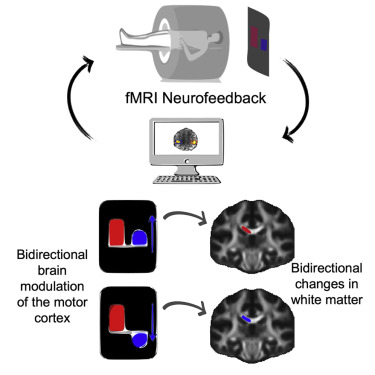Dr Cassandra Sampaio Baptista’s study published on Cell Reports
Published: 1 November 2021
Self-regulation of brain activity rapidly rewires brain connections in the adult human brai
How brain structure influences brain function has been extensively researched, but does brain activity regulation alter brain structure?
This study, led by Dr Sampaio Baptista based at University of Glasgow and a team of University of Oxford researchers, used a novel technique that allows participants to regulate their own brain activity, termed neurofeedback. The authors established that self-regulation of brain activity results in rapid rewiring of the connecting tracts, demonstrating that function can indeed regulate structure even in the adult human brain.
In the past researchers have used brain stimulation to change brain activity with the aim to improve symptoms in neurological disorders. Here, the authors used a different approach and trained participants to literally control their own brain activity. To do that they quickly analyse fMRI brain images as these are being acquired. This allows them to measure participant’s brain activity in specific regions and to show the participants a graphical representation of their own brain activity in a screen inside the scanner. Participants are then instructed to either increase or decrease the size of the bars that represent the activity of the target brain regions. This technique is usually referred to as real-time fMRI neurofeedback. Previous work has indicated that training with this technique can lead to changes in brain activity and behaviour, with potential benefits in a range of neurological or psychiatric disorders characterised by abnormal brain activity.
In the current study published in October in Cell Reports, the authors focused on the areas of the brain that control the movement of the hands in healthy individuals and asked participants to modulate the activity of these areas in opposite directions in two separate sessions. They tested these effects on brain structure using data driven methods.
First, the researchers found that the same individuals were able to control the activity of these areas in the direction, up or down, they were instructed to, within a single session. These findings have implications for precision medicine, as some patients might benefit from increases in brain activity and others from decreases.
Second, the authors established that the structure of the tracts that connect the two targeted areas was rapidly altered in the direction of the activity regulation. These exciting findings open up for the first time the possibility of using neurofeedback to directionally modulate not only brain function but also the structure of brain connections.

MRI is expensive, not cost effective and has limited practical applicability. However, because neurofeedback trains participants to regulate their own brain activity, it has some potential for real-world applications. For instance, participants might be able to learn beneficial strategies to control their brain activity inside the scanner. Identifying such successful strategies would allow them to continue to practice strategies outside the scanner, at home, and without any recording or stimulation equipment. More research is needed to establish if participants are able to continue to regulate their brain activity when not shown a representation of it. Alternatively, portable devices such as EEG can be used in combination or instead of MRI scans.
Neurofeedback can potentially be used to aid motor recovery in motor disorders, such as stroke, potentially through alterations of brain tracts as demonstrated in this study. The authors are also currently running a preregistered randomised sham controlled trial in stroke survivors to test this and other hypotheses.
Link here: https://www.sciencedirect.com/science/article/pii/S2211124721013607
If you would like to know more about the study or are interested in neurofeedback, contact Dr Cassandra Sampaio Baptista - cassandra.sampaiobaptista@glasgow.ac.uk.
First published: 1 November 2021

